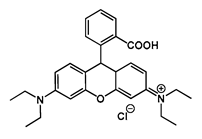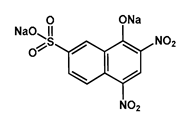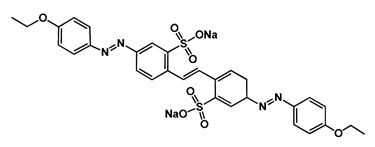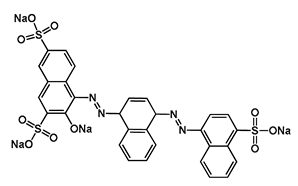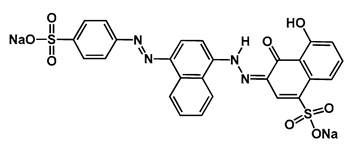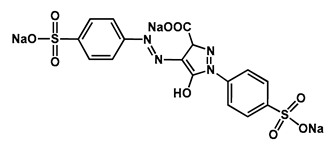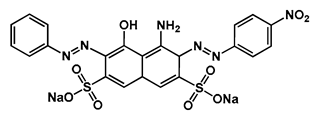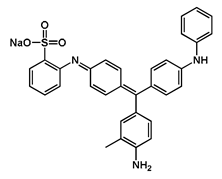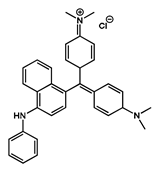Abstract
Chromotope, the 19th Century Chromatic Turn, is a multidisciplinary ERC research programme that focuses on the “chromatic turn” of the 1860s in France and England, following the invention of the first synthetic dyes. This project, based on a partnership between Sorbonne University (PI: Charlotte Ribeyrol), Oxford University, and the Conservatoire national des arts et métiers (Cnam), investigates how this turn led to new ways of thinking about colour in art, literature, history, and science throughout the second half of the 19th century. One of the key aims of this research is to reappraise the role played by the Cnam in the dissemination of knowledge about synthetic dyes, from the creation in 1852 of the first chair in dyeing and printing until the Interwar period, when a collection of dyes including more than 2500 references, obtained from major European firms, was formed. A full inventory based on the description of each container has just been made together with a bibliographical research. Nevertheless, 2% of the containers are unlabeled and the reattribution of their composition is the main goal of our study. In order to set an appropriate analysis protocol to identify these orphan containers, a preliminary work was conducted on a random selection of identified dyes. For this purpose, electrospray ionization mass spectrometry and Fourier-transform infrared spectroscopy were used on 13 samples from different dye classes. The relevance of this protocol will be discussed for the identification of unknown compounds.
1. Introduction
The Conservatoire national des arts et métiers (Cnam) in Paris was founded in 1794 by Abbé Grégoire to support the new processes and technical innovations in the field of industry. Until today, it has been a major teaching center based on the practice and experience of skills acquired through application, and renowned for its defence of education for all. The musée des Arts et Métiers, which is part of the Cnam, has been involved in the preservation of technical and industrial heritage since its creation. Thus, the museum is particularly interested in objects or material testimonies that have enabled or represent major technological developments in various fields. Both institutions are participating in the ERC’s Chromotope, the 19th Century Chromatic Turn [1], held by Sorbonne University in Paris, which aims to better understand the cultural impact of the emergence of synthetic dyes in Europe in the second half of the 19th century. Indeed, the discovery of these new materials in Europe at the end of the 1850s transformed the way of thinking about colour. Synthetic dyes revolutionized the European textile dyeing and printing industry, radically modifying technical processes and diversifying the range of accessible colours. In this context, together, the musée des Arts et Métiers along with the molecular chemistry team of the GBCM laboratory from the Conservatoire have conducted a study on a synthetic dyes collection from the 20th century related to the teaching of dyeing and printing techniques at the Cnam, introduced in Figure 1.
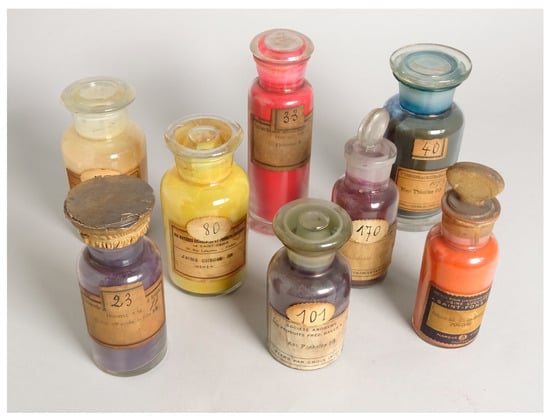
Figure 1.
Some dyes from the Cnam’s collection. Copyright © 2022 Photo by Irene Bilbao Zubiri, musée des Arts et Métiers, Cnam.
Indeed, the Conservatoire took part in the history of this upheaval by creating in 1852, as a result of the Paris Chamber of Commerce funding, the first chair dedicated to the “Dyeing, Printing, and Finishing of Textiles”. This chair, whose creation was almost synchronous with the discovery of the first synthetic dye in 1856 by Sir William Henry Perkin in England [2], aimed to meet the labour needs of Parisian textile printing companies. Jean-François Persoz (1805–1868), a Swiss practitioner and academic who trained with Louis Thénard at the Collège de France and wrote a famous Handbook [3], was appointed as the first professor. Four other professors succeeded him, but the content of the chair has evolved over time and has changed its name several times. The history of this chair and its evolution are well-known [4,5], and the period of interest here is that of André Wahl (1872–1944) [6], appointed in 1918 to the chair renamed chair of “Dyeing Chemistry”. The chair kept this name until 1941, when it was renamed “Organic Chemistry for applications”.
These dyes, collected as early as 1918 and until the 1970s, were probably used for educational purposes. However, there is no mention of their use in the rare documents relating to this chair, but its link is attested by the dye directory, a handwritten notebook that was retrieved at the same time as the collection, listing all the dyes and whose label on the front cover mentions the Cnam and the Dyeing Chemistry laboratory. Moreover, some objects of this collection have replacement labels, which also confirms their link with the chair. Both labels are presented in Figure 2. Moreover, in the dye directory, a number has been assigned to each container manufacture per manufacture, that allows us to identify each item. It brings also a dating element, as for the first dyes listed; Colour Index numbers are given, which refer to the first edition of the Colour Index of 1924 [7]. These data are consistent with the period of the chair of André Wahl.
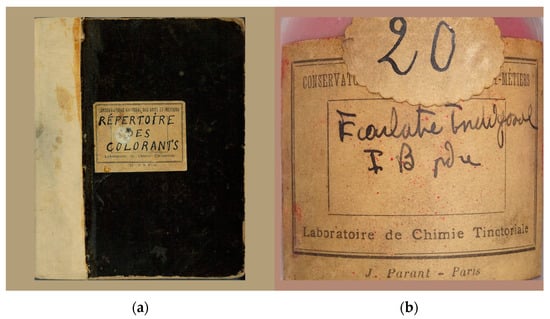
Figure 2.
(a) Front cover of the dye directory. (b) Replacement label from Durand et Huguenin’s manufacture. Copyright © 2022 Photo by Irene Bilbao Zubiri, musée des Arts et Métiers, Cnam.
Moreover, as this collection of synthetic dyes was given to the museum at the time of the removal of the laboratory which sheltered it, at the beginning of the years 2000, this study aims to carry out the necessary research to register its heritage status [8], while contributing the maximum information. A particular approach has been taken for the containers that no longer have their labels. Our final aim is to give the orphan vials the status of heritage object and thus to determine which compounds they contain. For this purpose, we have chosen to analyse a small selection of labeled dyes in order to establish a suitable analytical protocol that will allow the identification of unknown dyes in the near future.
Many different techniques have been successfully used in the past to characterize natural and synthetic dyes in heritage objects, beyond the multi-technique approach that seems to be the most suitable protocol to characterize dyes [9,10,11]. On the one hand, analytical separation methods such as high-performance liquid chromatography (HPLC) combined with mass spectrometry [12,13,14,15,16] have been successfully performed and can provide a lot of information about the dyes’ structure and their degradation products. In addition, non-invasive techniques are usually employed and their advantages and disadvantages have been highlighted in the literature [17]. Among these techniques, UV-Vis-NIR spectroscopy [18] and Raman spectroscopy [19,20,21,22,23,24,25] are mainly used. In the field of heritage conservation, often the dyes that are being examined have been used to dye textile fibres and so an extraction process is usually needed to get them off the fibre [26,27,28,29]; in addition, in the case of dyes with a high tinting strength, very little dye is actually present. Moreover, the frequent presence of dye mixtures further complicates the identification work and requires extensive reference work [30]. In addition, often the small amount of dye used to colour the fiber makes analysis difficult in the case of dyes with high dyeing strength [31,32]. In our study, these issues did not concern us because we had the advantage of working on powders, and assumed that the raw materials of the collection were free of mixtures insofar as these dyes were generally mixed later directly in the dye baths.
In our particular aim to identify the dyes in the unlabeled vials, we decided to combine two proven techniques: electrospray ionization mass spectrometry (ESI-MS) and Fourier-transform infrared spectroscopy (FTIR) [33,34,35,36]. ESI-MS as well as FTIR spectroscopy have been successfully used with other techniques by Longoni et al. [33] for the analysis of dyes very similar to those in the museum collection.
2. Materials and Methods
2.1. Inventory Work and Bibliographical Research on Dyes
The inventory work on the dye collection consisted of weighing, measuring, and giving detailed descriptions of each container. Photographs were also taken to assess a state of conservation at the time of the inventory. This work was carried out by first meeting the museum’s inventory criteria and by relying on the pre-inventory work carried out in 2018 by the museum’s inventory department. At that time, the containers were classified by manufacture and lists were drawn up of the containers present or absent in relation to the dye directory. The heritage we had at our disposal was therefore made up of containers from various factories, labelled or not, and some labels removed from the flasks. The classification work made it possible to locate them and to assign them an inventory number in the museum’s database with one record per object.
In parallel, we have carried out a bibliographical work [37,38,39,40] on the dyes present and well-named in the collection with the research of historical data on the one hand and chemical characteristics on the other hand to better define these dyes. Similarly, a great deal of work had to be done on containers that had very degraded and illegible labels or that had lost their labels, in order to attribute them to a manufacture and sometimes even to identify the dye from visual observations. These attributions are based on the typologies of the containers or flasks, sometimes on fragments of labels or on detached labels to re-attribute a flask.
2.2. The Collection and the Analysed Samples
About 2% of the collection involves gaps of attribution, as the concerned containers have lost their labels. Thus, we chose to perform chemical analyses on a selection of labeled vials containing dyes referenced in the literature [41]. These analyses performed on known products should be good indicators in terms of purity and chemical stability of the collection and should allow us to control the efficiency of the techniques chosen to analyse the different families of molecules and to evaluate the interest or the need of additional analyses. The first step in this work was to test the possibility of opening the containers as some of them cannot be opened because they kept their original corking, but also because these ancient stoppers present a certain resistance. It was a criterion included in the inventory work to know, before any sampling or analysis is considered and without further manipulation, the possibility of sampling each dye. For this purpose, 13 flasks were selected from 4 manufacturers. Before analysing the dyes, we were interested in the chemical properties of these compounds. Some parameters such as dye formula, molecular weight, dye class, and CAS number were collected. The dyes selected belong to different dye classes, taking into account that, for instance, azo dyes are much more represented in our collection (26% against 6% for anthraquinone dyes, for example). The compounds chosen were: Rhodamine B 1, Naphthol yellow S extra 2, Chrysamine G 3, Chrysophenine G 4, Naphthol black 6B 5, Victoria black B 6, Tartrazine 7, Naphthylamine black 4B 8, Alkali blue 4B 9, and Victoria blue B 10. Some of this data are summarized in Table 1 and supplemented in Section 3.

Table 1.
Analysed samples, chemical information, and factories which have produced them.
In addition, we have also compared samples with the same compound, produced by different companies: two vials for Rhodamine B 1 (one from Bayer and the other from Manufacture lyonnaise) and three vials for Alkali blue 4B 9 (two different from Bayer and one from Saint-Denis), in order to confirm and compare their composition, giving a total of 13 vials together. Indeed, the nomenclature of the dyes is an essential point which remains to be explored since, for certain products, several commercial names can correspond to the same molecule. It was decided to take samples only from unsealed vials (Figure 3). A very small quantity of powder was taken from the heart of the vial, excluding samples from areas exposed to light, as degradation could be observed in the case of photosensitive dyes. In the time available, the analysis strategy was to limit itself to one or two analytical techniques in order to obtain a quick response. For this purpose, ESI-MS and FTIR spectroscopy were chosen for this selection of dyes [42].
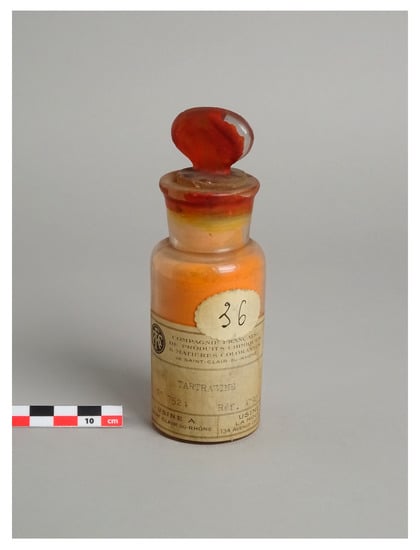
Figure 3.
Tartrazine from Compagnie française de produits chimiques et matières colorantes de Saint-Clair-du-Rhône. Copyright © 2022 Photo by Irene Bilbao Zubiri, musée des Arts et Métiers, Cnam.
2.2.1. ESI-Mass Spectrometry
A Shimadzu LCMS-2030 instrument was used, equipped with an automatic injector, electrospray ionization (ESI), and a quadrupole analyzer. The compounds were dissolved in methanol with a concentration of 0.1 mg/mL and no preliminary separation by liquid chromatography was carried out before direct injection into the mass spectrometer. Operation of the system and data analysis were performed using the LabSolutions software, and molecular detection was carried out in both the negative and positive ionization modes. The ESI experimental conditions were: interface voltage 4.5 kV, interface temperature 450 °C, desolvation line temperature 250 °C, nebulizing gas flow 0.5 mL/min, and heat block temperature 200 °C. MS data were acquired in the range 300–1000 m/z at scan speed 1500 u/s, and with Q-array RF voltage 60 V.
2.2.2. FTIR Spectroscopy
Infrared spectra were recorded over the 400–4000 cm−1 range with an Agilent Technologies Cary 630 FTIR/ATR/ZnSe spectrometer. All the samples were examined between 4000 and 650 cm−1, at a resolution of 8 cm−1, representing an average of 16 scans. The software used to acquire the spectra was MicroLab PC. The spectra were registered in transmission mode. The dyes, originally in a powder state, did not need additional sample preparation. These analyses were only carried out for compounds whose purity was attested by mass spectrometry.
3. Analytical Results
3.1. The Collection
First of all, the museum’s collection includes about 2630 containers from 25 European manufacturers from France, Germany, Switzerland, and England. In the early 20th century, many manufacturers worked with subsidiaries in foreign countries [43], as shown in the graph with the German and Swiss subsidiaries in France (Figure 4). This is the case, for instance, with the German manufacturer Farbenfabriken vormals Fried. Bayer & Co, which opened in 1863 a subsidiary under the same name in the north of France, or with Meister Lucius & Brüning, which opened a subsidiary in France, the Compagnie parisienne des couleurs d’aniline in 1888. In fact, since the second half of the nineteenth century, Germany has had a monopoly on the dye market, which is confirmed in our collection, since German production, whether in Germany or in France, is the most represented [44,45]. Other collections of dyes for educational purposes of this type exist in Europe, such as the German collections of Dresden and Cologne studied in the framework of the Weltbunt project [46,47]. These collections provide a better understanding of the circulation of dyeing materials in the late 19th and early 20th centuries.
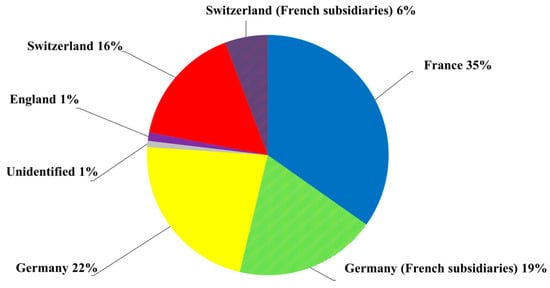
Figure 4.
Distribution of the collection by country.
The vast majority is stored in glass containers, but the museum also owns 65 metal and 15 plastic containers. Among the glass bottles, there are different types of stoppers, mainly depending on the manufacturer, and almost 17% of the flasks keep the original glass stopper covered with paper, leather, or wax, and have never been opened (Figure 5). The dyes are mostly in powder form and this is particularly interesting in terms of analysis and sampling, in contrast to the analysis of textile samples which are more commonly studied [48,49]. The vials contain, on average, around 140 g of dye, and sampling does not denature the object.
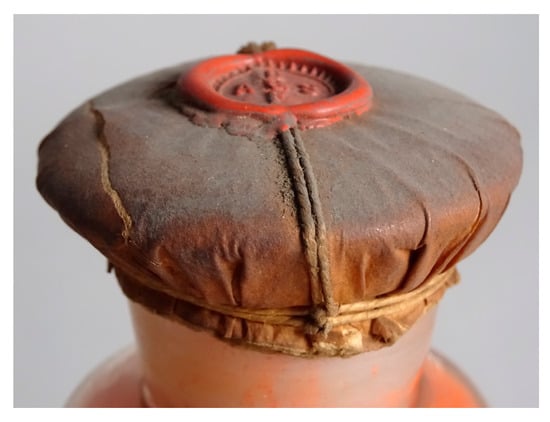
Figure 5.
Sealed flask from B.A.S.F.: Fuscaline orange GN powder. Copyright © 2022 Photo by Irene Bilbao Zubiri, musée des Arts et Métiers, Cnam.
Among the conservation issues encountered, we noticed on some bottles of this collection that the papers labels were degraded. Almost all the flasks from A.G.F.A. (Aktiengesellschaft für Anilinfabrikation), B.A.S.F. (Badische Anilin & Soda-Fabrik), and Société chimique des usines du Rhône have powdery labels on their entire surface (Figure 6). This very poor state of preservation was probably aggravated by the poor storage conditions. However, as all labels are damaged, the quality of the paper is certainly an aggravating factor. On the other hand, the labels of the Bayer factory are partly damaged because of an old pressure-sensitive adhesive tape, often on the name of the dye, that has become hard and highly discoloured. In this area, the yellowish-brown adhesive appears to have penetrated the paper, which is quite common on archives, books, and paper artworks [50]. It was beyond the scope of the current work to carry out analysis of the adhesive of the deteriorated pressure-sensitive tape. Unfortunately, half of Bayer’s labels are degraded, detached, or lost. We have been led to ask ourselves how to approach these objects of unknown composition in order to give them heritage status. We have therefore made hypotheses about their composition not only based on the fragments of labels still visible and the colours of the dyes, but also by referring to the dye directory. However, these hypotheses, which are often based on a limited number of elements, are not satisfactory for identifying them. Our objective is to identify the structures of the dyes contained in these flasks, by carrying out a series of chemical analyses, and to reassign their labels when they become available.
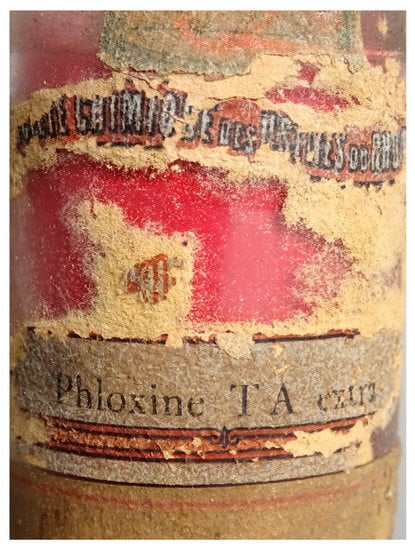
Figure 6.
Pulverulent label from Société chimique des usines du Rhône: Phloxine TA extra. Copyright © 2022 Photo by Irene Bilbao Zubiri, musée des Arts et Métiers, Cnam.
3.2. The Analytical Data
3.2.1. Xanthene Dyes
One xanthene dye was analysed, Rhodamine B 1 [CAS 81-88-9, C.I. 45170], a red dye discovered in 1887 by M. Ceresole and marketed one year later by the Farbenfabriken vormals Fried. Bayer & Co. and by the Société pour l’Industrie Chimique in Basel. Its generic name is “basic violet 10”. Here, two samples from two different factories, one German and one French, Bayer and Manufacture lyonnaise de matières colorantes, were analysed. The data presented here are from the analysis of the French manufacturer container. The results of the mass spectrometry and infrared spectroscopy analyses show that they are the same molecule, illustrating a good correspondence of the nomenclature between two dyes from two different European factories. Negative ionization ESI-MS analysis confirmed the presence of the expected dye with a base peak at m/z = 443 attributed to [M-Cl]+ and a second peak at m/z = 444 attributed to [M+H-Cl] (Figure 7). Although a photo-degradation process of several rhodamines, including Rhodamine B 1, has been reported in the literature [51], in the case of our vial, the product did not undergo degradation and remained pure.

Figure 7.
ESI-MS spectrum of Rhodamine B 1.
The infrared spectrum of Rhodamine B 1 is reported in the literature [52]. It shows a broad band at 3267 cm−1, characteristic of stretching vibrations of the O-H group, and the band at 1691 cm−1 has been attributed to the stretching vibration of the C=O bond, both related to the carboxylic acid (Figure 8). The conjugated C=C double bonds of the xanthene ring give three bands of varying intensities at 1469, 1587, and 1644 cm−1, attributed to the stretching-type vibration. The bending of the C-H bond of the diethylamine group is visible at 1409 cm−1 and the band at 1341 cm−1 is here attributed to the stretching vibration of the Ar-N bond of the same group. Finally, the band at 1074 cm−1 is attributed to the stretching vibration of C-O-H and the very intense band at 1002 cm−1 to the stretching of the C-O bond.
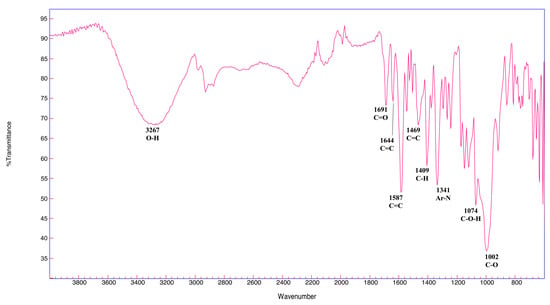
Figure 8.
FTIR spectrum of Rhodamine B 1.
3.2.2. Nitro Dyes
Naphthol yellow S extra 2 [CAS 846-70-8, C.I. 10316], a bright yellow dye belonging to the nitro dyes, was discovered in 1879 by Heinrich Caro from B.A.S.F., and was taken from a flask belonging to the Compagnie de produits chimiques et matières colorantes de Saint-Clair-du-Rhône. Its generic name is “acid yellow 1” and the extra mention refers to a product of great purity. The negative ionization spectrum for this compound gives a base peak at m/z = 313 attributed to [M+H-2Na]−, resulting from the ionization of Naphthol yellow S 2 (Figure 9).

Figure 9.
ESI-MS spectrum of Naphthol yellow S extra 2.
Concerning the IR spectrum, as in the case of Rhodamine B 1, the conjugated C=C bonds give three peaks of diverse intensity at 1458, 1583, and 1620 cm−1 (Figure 10). Concerning the two nitro groups, they should give a response for the N-O asymmetric stretch vibration in the range 1550–1475 cm−1 and the N-O symmetric stretch vibration around 1360–1290 cm−1. In our spectrum, two bands at 1502 and 1323 cm−1 are attributed to the N-O asymmetric and symmetric stretching-type vibrations, respectively [53]. The band at 1323 cm−1 is here attributed to the S=O stretching-type vibrations of the sulfonate group and the strongest one at 1194 cm−1 can be assigned to the Ar-O stretching vibration on the naphthol ring.
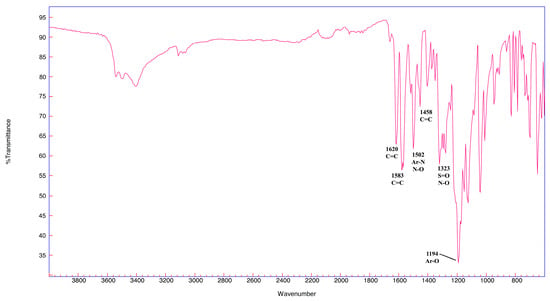
Figure 10.
FTIR spectrum of Naphthol yellow S extra 2.
3.2.3. Azo Dyes
Chrysamine G 3 [CAS 6472-91-9, C.I. 22250] is a diazo yellow dye that was discovered in 1884 by E. Franck. Its generic name is “direct yellow 1”. An analysis by negative ionization mass spectrometry identified the peak at m/z = 503 attributed to the monosodium salt [M-Na]− and the base peak at m/z = 481 is assigned to [M+H-2Na]− (Figure 11). Moreover, the peak at m/z = 317 corresponds to an α-cutoff of the diazo bond.

Figure 11.
ESI-MS spectrum of Chrysamine G 3.
The broad band at 3318 cm−1 is here attributed to the stretching vibration of the O-H band of both carboxylic acid and phenol (Figure 12). FTIR analyses on azo dyes are reported in the literature [54,55]. In our study, the band at 1583 cm−1 is assigned to the cumulative signal of the stretching vibration of the C=C and N=N bonds. Indeed, the 1400–1600 cm−1 region corresponds to the aromatic ring region, but between 1500–1600 cm−1, we also have the signal of the azo bond, and usually the main band for this bond is around 1500 cm−1. At 1457 cm−1, the band is attributed to the C=C stretching vibration and the one at 1486 cm−1 to the azo bond. The very intense band at 828 cm−1 may correspond to a bending vibration on the Ar-H bond in trisubstituted aromatic rings.
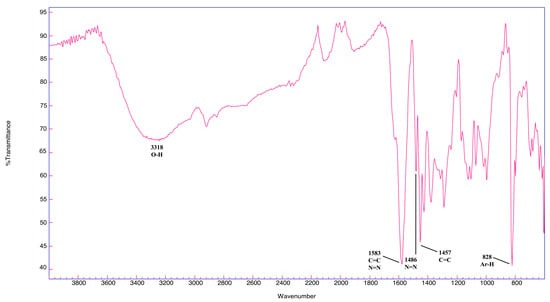
Figure 12.
FTIR spectrum of Chrysamine G 3.
Victoria black B 6 [CAS 6226-94-4, C.I. 27510] was discovered in 1889 by M. Ulrich and C. Duisberg, and its generic name is “acid black 5”. It was correctly identified in the negative ionization mode with a base peak at m/z = 599 which corresponds to the monosodium salt [M-Na]−, but also with a secondary peak at m/z = 577 assigned to [M+H-2Na]− (Figure 13). The peak at m/z = 392 corresponds to an α-cutoff of the diazo bond. The three fragments assigned to this dye resulting from the ionization are very consistent with the composition expected. The mixing of compounds was a common practice in dyeing with natural or synthetic dyes, as has been pointed out in the literature [9,56,57]. It seems that mixing an orange dye with a black-based dye was a common practice to avoid purplish hues on black dyes. In [41], a textile sample theoretically dyed with Victoria black B contained orange I (m/z = 327). The peak we obtained at m/z = 327 could confirm this statement, even if it is very weak.

Figure 13.
ESI-MS spectrum of Victoria black B 6.
The infrared spectrum of Victoria black B 6 shows a broad band at 3381 cm−1 assigned to the stretching vibration of an O-H bond and the azo bond gives a response at 1497 cm−1 (Figure 14). Morever, the Ar-OH that is usually between 1000 and 1400 cm−1 is observed at 1000 cm−1. This lower position is probably related to the sulfonate in para position as the substituent in the same benzenic ring. In addition, the sulfonate group should give a band between 1145–1200 cm−1. Thus, in our sample the bands in the range 1145–1200 correspond to the stretching vibration in O-H and S=O. Moreover, the band at 1457 cm−1 is attributed to the stretching vibration of the C=C bond.
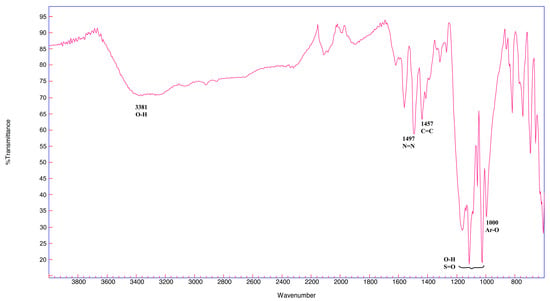
Figure 14.
FTIR spectrum of Victoria black B 6.
Naphthylamine black 4B 8 [CAS 1064-48-8, C.I. 20470] is a diazo dye whose family was discovered in 1888 by the German manufacture Leopold Cassella. Its generic name is “acid black 1”. Negative ionization mode mass spectrometry analyses show a base peak at m/z = 690 and a secondary signal, very intense, at m/z = 610, which we have not attributed (Figure 15). A secondary peak at m/z = 571 is attributed to the ion [M+H-2Na]−. Due to the numerous major bands we obtain, we assume a mixture of different dyes, perhaps with the same intention on black dyes mentioned above.

Figure 15.
ESI-MS spectrum of Naphthylamine black 4B 8.
Among the azo dyes that were analysed, three could not be identified by mass spectrometry. First, the yellow-orange monoazo dye Tartrazine 7 [CAS 1934-21-0, C.I. 19140], whose spectrum in both ionization modes shows too many peaks and none can be assigned to the expected dye. These statements suggest that this sample has probably degraded. This dye was not successfully identified on the fiber either, as reported by Baker in 2011 [26]. Secondly, Naphthol black 6B 5 [CAS 8004-66-8, C.I. 27240] was analysed and the mass spectrum shows numerous peaks throughout the spectrum range and the expected compound could not be identified, suggesting degradation as with the dye mentioned above. Thirdly, the analysis of the yellow dye Chrysophenine G 4 [CAS 2870-32-8, C.I. 24895] also provided attribution difficulties. In the negative ionization mode, we obtained a base peak at m/z = 303 that did not correspond to the dye expected or to an ion resulting from its fragmentation (Figure 16). Moreover, we observed a peak at m/z = 629, which does not correspond to this dye either. We conclude that we have found the presence of several unidentified compounds as the MS analysis gave a spectrum with three distinct peaks, which rather suggests a mixture of dyes than a degradation.

Figure 16.
ESI-MS spectrum of Chrysophenine G 4.
In these three cases, we can conclude that these products were not pure or have degraded. The protocol based on ESI-MS and FTIR spectroscopy analysis did not allow us to correctly identify these samples and other techniques should be used to confirm the presence of these compounds.
3.2.4. Triarylmethine Dyes
Alkali blue 4B 9 [CAS 62152-67-4, C.I. 42750] was discovered in 1862 by E.C. Nicholson and is identified in the Colour Index by the generic name “acid blue 110”. Three samples of this dye, two different vials from Bayer and one from the Société des matières colorantes et produits chimiques de Saint-Denis, were analysed. Again, as in the case of Rhodamine B 1, the ESI-MS and FTIR spectroscopy results give the same spectra, with minor differences in intensity in infrared spectroscopy. In the positive ionization spectrum, three peaks at m/z = 532, m/z = 531 and m/z = 530 can be observed. The peak at m/z = 532 is here attributed to [M-Na]− (Figure 17).

Figure 17.
ESI-MS spectrum of Alkali blue 4B 9.
In infrared spectroscopy, the band at 3347 cm−1 is attributed to the imine group and the Ar=N bond, as with the one at 1592 cm−1 (Figure 18). The band at 1495 cm−1 corresponds to the C=C bond stretching vibration in the aromatic ring but also to the azo bond, expected at approximately 1500 cm−1. At 1312 cm−1, we have a cumulative signal attributed to the Ar2-N, Ar-NH2, and S=O stretching vibration. The sulfonate group vibration is also present in the band at 1167 cm−1. At 1120 cm−1, the signal corresponds to the stretching vibration of the Ar-N bond and finally, at 1033 cm−1 we have a C-H bending vibration.
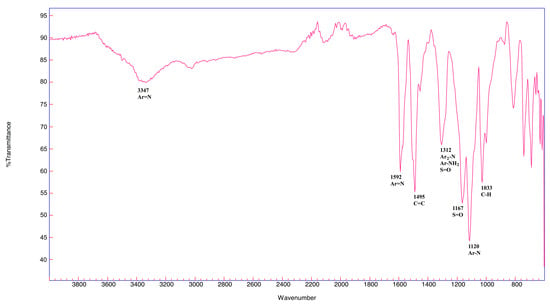
Figure 18.
FTIR spectrum of Alkali blue 4B 9.
Victoria Blue B 10 [CAS 2580-56-5, C.I. 44045] is the second triarylmethine dye analysed. This blue dye was discovered in 1883 by Heinrich Caro and Adolf Kern. Its generic name is “basic blue 26”. Mass spectrometry analysis allowed us to identify the peak at m/z = 471 to [M-Cl]+, which proves the presence of the expected dye (Figure 19).

Figure 19.
ESI-MS spectrum of Victoria Blue B 10.
The FTIR spectrum of Victoria blue B 10 has been reported in the literature [58]. In our study, three distinct regions were identified between 1000 and 1600 cm−1 (Figure 20). Firstly, the band at 1582 cm−1 is here attributed to the bending vibration of the C=C of Ar=N+ [59], or the stretching vibration of the aromatic C=C para-disubstituted ring (C-Ph-N). The one at 1490 cm−1 is related to the stretching vibration of C=C. The band at 1288 cm−1 is assigned to the stretching vibration of the C-N bond and the one at 1357 cm−1 to the bending vibration of two bonds: CH3 and N-H. Those at 1027 and 1162 cm−1 are here attributed to the Ar-H bond.
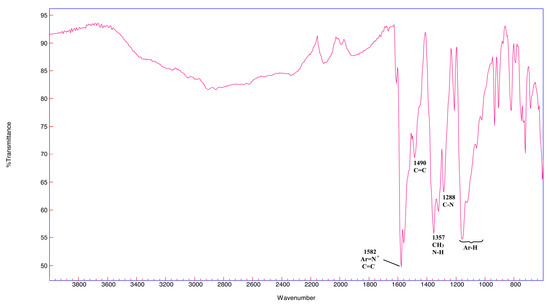
Figure 20.
FTIR spectrum of Victoria Blue B 10.
4. Conclusions
Analyses of the 13 samples corresponding to ten different dyes have helped to clarify some of the attribution issues. Nine samples corresponding to six different dyes were correctly identified by mass spectrometry and gave very consistent FTIR spectra. For the four remaining dyes, two cases were presented. Regarding the hypothesis of a mixture of a black dye with orange dyes, the analysis of Naphthylamine black 4B 8 could indicate that the mixing with dyes was done before the preparation of the dyebath, and before the marketing of the vials. To confirm this, it would be necessary to analyse a wider range of black samples. Moreover, mass spectrometry analyses of Chrysophenine G 4, Naphthol black 6B 5, and Tartrazine 7 did not allow us to identify these dyes. Moreover, the comparison of results for the same dye taken from vials of different manufactures was very conclusive, as the signals obtained attest to the same composition.
The analytical work carried out on a random selection of dyes has also allowed us to have a brief overview of the state of conservation of these compounds, which completes the visual observations made beforehand. Moreover, working on powdered dyes directly and without prior treatment of the samples represents a great advantage. Even if the dyes of the musée des Arts et Métiers collection are less pure than expected, these results are encouraging and the protocol could probably be applied to a particularly interesting part of the collection, the Bayer vials. Among the 288 dyes from this company, 47 containers have lost their labels. The next step will be to continue testing this group to identify the composition of these dyes, while referring to the dye directory and the currently missing dyes. ESI-MS and FTIR spectroscopy analysis seem appropriate for the identification of undegraded, unmixed compounds, as long as we know the molecular weights of the absent compounds. We plan to complete the characterization by other techniques such as UV-Vis spectroscopy when MS and FTIR spectroscopy do not provide sufficient identification arguments.
The collection of dyes will be accessible on the museum’s database with limited scientific data, with each one signaled with a photograph and the commercial name of the product. This will allow a better knowledge of these chemicals and a broader perspective on the issues of the conservation of European chemical heritage.
Author Contributions
Conceptualization, I.B.Z. and A.-L.C.; methodology, I.B.Z. and A.-L.C.; formal analysis, I.B.Z.; writing—original draft preparation, I.B.Z.; writing—review and editing, I.B.Z. and A.-L.C.; visualization, I.B.Z. All authors have read and agreed to the published version of the manuscript.
Funding
This project has received funding from the European Research Council (ERC) under the European Union’s Horizon 2020 research and innovation programme (grant agreement No. 818563—CHROMOTOPE).
Data Availability Statement
The inventory work on the collection will be available on the musée des Arts et Métiers website at the following link https://www.arts-et-metiers.net/les-collections; (accessed on 14 February 2023).
Acknowledgments
The authors are grateful to Clotilde Ferroud, Fabienne Dioury—research engineer, and Maité Sylla from the GBCM laboratory (Cnam) for their co-operation and support throughout this work.
Conflicts of Interest
The authors declare no conflict of interest.
References
- Project Chromotope, the 19th Century Chromatic Turn Home Page. Available online: https://chromotope.eu (accessed on 4 November 2022).
- Bensaude-Vincent, B.; Stengers, I. La bataille des colorants. In Histoire de la Chimie; Bensaude-Vincent, B., Stengers, I., Poche, Eds.; La Découverte: Paris, France, 2011; pp. 231–240. [Google Scholar]
- Persoz, J.-F. Traité Théorique et Pratique de L’impression sur Étoffes; Masson: Paris, France, 1846; 4 volumes and one atlas. [Google Scholar]
- Déré, A.-C. La chaire des colorants. In 1794–1994: Le Conservatoire des Arts et Métiers au Cœur de Paris; DAAP: Paris, France, 1994; pp. 108–113. [Google Scholar]
- Bilbao Zubiri, I.; Carré, A.-L.; Meynard, A. Des colorants à l’étude: Une participation du musée des Arts et Métiers au projet Chromotope. Coré 2023, 6. [Google Scholar]
- Zvenigorodski, O. André Wahl. In Les Professeurs du Conservatoire National des Arts et Métiers. Dictionnaire Biographique 1794–1955; Fontanon, C., Grelon, A., Eds.; INRP: Paris, France, 1994; Volume 2, pp. 667–676. [Google Scholar]
- Rowe, F.-M. The Colour Index, 1st ed.; Society of Dyers and Colourists: Bradford, UK, 1924. [Google Scholar]
- Service des Musées de France de la Direction Générale des Patrimoines et de L’architecture. Inventorier et Récoler les Collections des Musées de France, Ministère de la Culture Web Page. Available online: https://www.culture.gouv.fr/Thematiques/Musees/Pour-les-professionnels/Conserver-et-gerer-les-collections/Gerer-les-collections/Inventorier-et-recoler-les-collections-des-musees-de-France (accessed on 18 January 2023).
- Zaffino, C.; Passaretti, A.; Poldi, G.; Fratelli, M.; Tibiletti, A.; Bestetti, R.; Saccani, I.; Guglielmi, V.; Bruni, S. A Multi-Technique Approach to the Chemical Characterization of Colored Inks in Contemporary Art: The Materials of Lucio Fontana. J. Cult. Herit. 2017, 23, 87–97. [Google Scholar] [CrossRef]
- Chieli, A.; Sanyova, J.; Doherty, B.; Brunetti, B.G.; Miliani, C. Chromatographic and Spectroscopic Identification and Recognition of Ammoniacal Cochineal Dyes and Pigments. Spectrochim. Acta Part A Mol. Biomol. Spectrosc. 2016, 162, 86–92. [Google Scholar] [CrossRef] [PubMed]
- Pirok, B.W.J.; Den Uijl, M.J.; Moro, G.; Berbers, S.V.J.; Croes, C.J.M.; van Bommel, M.R.; Schoenmalers, P.J. Characterization of Dye Extracts from Historical Cultural-Heritage Objects Using State-of-the-Art Comprehensive Two-Dimensional Liquid Chromatography and Mass Spectrometry with Active Modulation and Optimized Shifting Gradients. Anal. Chem. 2019, 91, 3062–3069. [Google Scholar] [CrossRef]
- Liu, J.; Zhou, Y.; Zhao, F.; Peng, Z.; Wang, S. Identification of Early Synthetic Dyes in Historical Chinese Textiles of the Late Nineteenth Century by High-performance Liquid Chromatography Coupled with Diode Array Detection and Mass Spectrometry. Color. Technol. 2016, 132, 177–185. [Google Scholar] [CrossRef]
- Souto, C. Analysis of Early Synthetic Dyes with HPLC-DAD-MS: An Important Database for Analysis of Colorants Used in Cultural Heritage. Master’s Thesis, Universidade Nova de Lisboa, Lisbon, Portugal, 2010. [Google Scholar]
- Petroviciu, I.; Vanden Berghe, I.; Cretu, I.; Albu, F.; Medvedovici, A. Identification of natural dyes in historical textiles from Romanian collections by LC-DAD and LC-MS (single stage and tandem MS). J. Cult. Herit. 2012, 13, 89–97. [Google Scholar] [CrossRef]
- Degano, I.; Sabatini, F.; Braccini, C.; Colombini, M.P. Triarylmethine dyes: Characterization of isomers using integrated mass spectrometry. Dye. Pigment. 2019, 160, 587–596. [Google Scholar] [CrossRef]
- Soltzberg, L.J.; Hagar, A.; Kridaratikorn, S.; Mattson, A.; Newman, R. MALDI-TOF mass spectrometric identification of dyes and pigments. J. Am. Soc. Mass Spectr. 2007, 18, 2001–2006. [Google Scholar] [CrossRef]
- Gulmini, M.; Idone, A.; Diana, E.; Gastaldi, D.; Vaudan, D.; Aceto, M. Identification of Dyestuffs in Historical Textiles: Strong and Weak Points of a Non-Invasive Approach. Dye. Pigment. 2013, 98, 136–145. [Google Scholar] [CrossRef]
- Montagner, C.; Bacci, M.; Bracci, S.; Freeman, R.; Picollo, M. Library of UV-Vis-NIR Reflectance Spectra of Modern Organic Dyes from Historic Pattern-Card Coloured Papers. Spectrochim. Acta Part A Mol. Biomol. Spectrosc. 2011, 79, 1669–1680. [Google Scholar] [CrossRef]
- Vandenabeele, P.; Moens, L.; Edwards, H.G.M.; Dams, R. Raman Spectroscopic Database of Azo Pigments and Application to Modern Art Studies. J. Raman Spectrosc. 2000, 31, 509–517. [Google Scholar] [CrossRef]
- Pozzi, F.; Leona, M. Surface-Enhanced Raman Spectroscopy in Art and Archaeology. J. Raman Spectrosc. 2016, 47, 67–77. [Google Scholar] [CrossRef]
- Doherty, B.; Gabrieli, F.; Clementi, C.; Cardon, D.; Sgamellotti, A.; Brunetti, B.; Miliani, C. Surface enhanced Raman spectroscopic investigation of orchil dyed wool from Roccella tinctoria and Lasallia pustulata. J. Raman Spectrosc. 2014, 45, 723–729. [Google Scholar] [CrossRef]
- Sessa, C.; Weiss, R.; Niessner, R.; Ivleva, N.P.; Stege, H. Towards a Surface Enhanced Raman Scattering (SERS) Spectra Database for Synthetic Organic Colourants in Cultural Heritage. The Effect of Using Different Metal Substrates on the Spectra. Microchem. J. 2018, 138, 209–225. [Google Scholar] [CrossRef]
- Cesaratto, A.; Luo, Y.B.; Smith, H.D.; Leona, M. A Timeline for the Introduction of Synthetic Dyestuffs in Japan during the Late Edo and Meiji Periods. Herit. Sci. 2018, 6, 22. [Google Scholar] [CrossRef]
- Cañamares, M.V.; Reagan, D.A.; Lombardi, J.R.; Leona, M. TLC-SERS of Mauve, the First Synthetic Dye. J. Raman Spectrosc. 2014, 45, 1147–1152. [Google Scholar] [CrossRef]
- Serafini, I.; Ciccola, A. Nanotechnologies and Nanomaterials: An Overview for Cultural Heritage. In Nanotechnologies and Nanomaterials for Diagnostic, Conservation and Restoration of Cultural Heritage; Lazzara, G., Fakhrulli, R.F., Eds.; Elsevier: Amsterdam, The Netherlands, 2018; pp. 325–380. [Google Scholar]
- Baker, R.M. Nineteenth Century Synthetic Textile Dyes. Their History and Identification on Fabric. Ph.D. Thesis, University of Southampton, Southampton, UK, September 2011. [Google Scholar]
- Bonacini, I.; Gallazzi, F.; Espina, A.; Cañamares, M.V.; Prati, S.; Mazzeo, R.; Sanchez-Cortes, S. Sensitive ‘on the Fiber’ Detection of Synthetic Organic Dyes by Laser Photoinduced Plasmonic Ag Nanoparticles. J. Raman Spectrosc. 2017, 48, 925–934. [Google Scholar] [CrossRef]
- Serafini, I.; Lombardi, L.; Vannutelli, G.; Montesano, C.; Sciubba, F.; Guiso, M.; Curini, R.; Bianco, A. How the extraction method could be crucial in the characterization of natural dyes from dyed yarns and lake pigments: The case of American and Armenian cochineal dyes, extracted through the new ammonia-EDTA method. Microchem. J. 2017, 134, 237–245. [Google Scholar] [CrossRef]
- Lombardi, L.; Serafini, I.; Guiso, M.; Sciubba, F.; Bianco, A. A new approach to the mild extraction of madder dyes from lake and textile. Microchem. J. 2016, 126, 373–380. [Google Scholar] [CrossRef]
- Serafini, I.; Lombardi, L.; Fasolato, C.; Sergi, M.; Di Ottavio, F.; Sciubba, F.; Montesano, C.; Guiso, M.; Costanza, R.; Nucci, L.; et al. A New Multi Analytical Approach for the Identification of Synthetic and Natural Dyes Mixtures. The Case of Orcein-Mauveine Mixture in a Historical Dress of a Sicilian Noblewoman of Nineteenth Century. Nat. Prod. Res. 2017, 33, 1040–1051. [Google Scholar] [CrossRef]
- Goodpaster, J.V.; Liszewski, E.A. Forensic Analysis of Dyed Textile Fibers. Anal. Bioanal. Chem. 2009, 394, 2009–2018. [Google Scholar] [CrossRef] [PubMed]
- Kuckova, S.; Nemec, I.; Hynek, R.; Hradilova, J.; Grygar, T. Analysis of organic colouring and binding components in colour layer of art works. Anal. Bioanal. Chem. 2005, 382, 275–282. [Google Scholar] [CrossRef] [PubMed]
- Longoni, M.; Gavazzi, M.; Monti, D.; Bruni, S. Early synthetic textile dyes of the late 19th century from the «Primo Levi» Chemistry Museum (Rome): A multi-technique analytical investigation. J. Cult. Herit. 2023, 59, 131–139. [Google Scholar] [CrossRef]
- Gillard, R.D.; Hardman, S.M.; Thomas, R.G.; Watkinson, D.E. The detection of dyes by FTIR. Stud. Conserv. 1994, 39, 187–192. [Google Scholar]
- Sato, M.; Sasaki, Y. Studies on ancient Japanese silk fibres using FT-IR microscopy. In Proceedings of the AHRB Research Centre for Textile Conservation and Textile Studies, First Annual Conference: Scientific Analysis of Ancient and Historic Textiles, Glasgow, UK, 13–15 July 2004; Janaway, R.C., Wyeth, P., Eds.; Archetype Press: London, UK, 2005. [Google Scholar]
- Schaening, A.; Schreiner, M.; Jembrih-Simbuerger, D. Identification and classification of synthetic organic pigments of a collection of the 19th and 20th century by FTIR. In Proceedings of the Sixth Infrared and Raman Users Group Conference (IRUG6), Florence, Italy, 29 March–1 April 2004; pp. 302–305. [Google Scholar]
- Ehrmann, E. Traité des Matières Colorantes Organiques et de Leurs Diverses Applications; Dunod: Paris, France, 1922; 615p. [Google Scholar]
- Dépierre, J. Traité de la Teinture et de L’impression des Matières Colorantes Artificielles; Béranger: Paris, France, 1903; Volume 5, 624p. [Google Scholar]
- Cain, J.C.; Thorpe, J.F. Les Matières Colorants de Synthèse et les Produits Intermédiaires Servant à leur Fabrication; Dunod: Paris, France, 1922; 666p. [Google Scholar]
- Seyewetz, A.; Sisley, P. Chimie des Matières Colorantes Artificielles; Masson: Paris, France, 1896; 826p. [Google Scholar]
- Tamburini, D.; Shimada, C.M.; McCarthy, B. The molecular characterization of early synthetic dyes in E. Knecht et al.’s textile sample book “A Manual of Dyeing” (1893) by high performance liquid chromatography—Diode array detector—Mass spectrometry (HPLC-DAD-MS). Dye. Pigment. 2021, 190, 109286. [Google Scholar] [CrossRef]
- GBCM Laboratory, Molecular Chemistry Team Home Page. Available online: https://gbcm.cnam.fr/equipe-3/ (accessed on 4 November 2022).
- Sakudo, J. Les Entreprises de la Chimie en France de 1860 à 1932; PIE Peter Lang: Bruxelles, Belgium, 2011; 290p. [Google Scholar]
- Travis, A.S. The Rainbow Makers: The origins of the Synthetic Dyestuffs Industry in Western Europe; Lehigh University Press: Bethlehem, Palestine; Associated University Presses: London, UK; Toronto, ON, Canada, 1993; 335p. [Google Scholar]
- Langlinay, E. Apprendre de l’Allemagne? Les scientifiques et industriels français de la chimie et l’Allemagne entre 1871 et 1914. In L’économie, L’argent et les Hommes: Les Relations Franco-Allemandes de 1871 à nos Jours; Eck, J.-F., Martens, S., Schürmann, S., Eds.; Institut de la gestion publique et du développement économique: Paris, France, 2009; pp. 113–129. [Google Scholar]
- Holly, M.; Herm, C.; Schram, J. Conserving the Rainbow: First Approaches towards the Preservation of the Dye Collection of the Hochschule Niederrhein. Dye. Hist. Archaeol. 2023, 37, 262–271. [Google Scholar]
- Holly, M. Farbe als Objekt. Die Erforschung der Farbstoffsammlung der Hochschule Niederrhein in Krefeld. In Proceedings of the Zur Sache! Objektwissenschaftliche Ansätze der Sammlungsforschung, Tübingen, Germany, 6–8 September 2018; Eberhard Karls Universität Tübingen: Tübingen, Germany, 2019. [Google Scholar] [CrossRef]
- Lech, K.; Wilicka, E.; Witowska-Jarosz, J.; Jarosz, M. Early synthetic dyes—A challenge for tandem mass spectrometry. J. Mass. Spectrom. 2013, 48, 141–147. [Google Scholar] [CrossRef]
- Woodhead, A.; Cosgrove, B.; Church, J.S. The purple coloration of four late 19th century silk dresses: A spectroscopic investigation. Spectrochim. Acta Part A Mol. Biomol. Spectrosc. 2016, 154, 185–192. [Google Scholar] [CrossRef]
- Gorassini, A.; Adami, G.; Calvini, P.; Giacomello, A. ATR-FTIR characterization of old pressure sensitive adhesive tapes in historic papers. J. Cult. Herit. 2016, 21, 775–785. [Google Scholar] [CrossRef]
- Sabatini, F.; Giugliano, R.; Degano, I. Photo-oxidation processes of Rhodamine B: A chromatographic and mass spectrometric approach. Microchem. J. 2018, 140, 114–122. [Google Scholar] [CrossRef]
- Lavate, D.; Sawant, V.; Khomane, A. Photodegradation of Rhodamine-B Dye under Natural Sunlight using CdO. Bull. Chem. React. Eng. Catal. 2022, 17, 466–475. [Google Scholar] [CrossRef]
- Bartošová, A.; Blinová, L.; Sitotiak, M.; Michalíková, A. Usage of FTIR-ATR as Non-Destructive Analysis of Selected Toxic Dyes; Research papers Faculty of Materials Science and Technology; Slovak University of Technology: Bratislava, Slovakia, 2017; Volume 25, pp. 103–111. [Google Scholar] [CrossRef]
- Ahmed, F.; Dewani, R.; Pervez, M.K.; Mahboob, S.J.; Soomro, S.A. Non-destructive FT-IR analysis of mono azo dyes. Bulg. Chem. Commun. 2016, 48, 71–77. [Google Scholar]
- Majeed, H.A.S.A.; Al-Ahmad, A.Y.; Hussain, H.A. The Preparation, Characterization and the Study of the Linear Optical Properties of a New Azo Compound. J. Basrah Res. 2011, 37, 64–73. [Google Scholar]
- Cesaratto, A.; Leona, M.; Pozzi, F. Recent Advances on the Analysis of Polychrome Works of Art: SERS of Synthetic Colorants and Their Mixtures With Natural Dyes. Front. Chem. 2019, 7, 105. [Google Scholar] [CrossRef] [PubMed]
- Degano, I.; Ribechini, E.; Modugno, F.; Colombini, M.P. Analytical Methods for the Characterization of Organic Dyes in Artworks and in Historical Textiles. Appl. Spectrosc. Rev. 2009, 44, 363–410. [Google Scholar] [CrossRef]
- Doherty, B.; Vagnini, M.; Dufourmantelle, K.; Sgamellotti, A.; Brunetti, B.; Miliani, C. A vibrational spectroscopic and principal component analysis of triarylmethane dyes by comparative laboratory and portable instrumentation. Spectrochim. Acta A 2014, 121, 292–305. [Google Scholar] [CrossRef]
- Kumar, C.G.; Mongolla, P.; Basha, A.; Joseph, J.; Sarma, V.U.; Kamal, A. Decolorization and biotransformation of triphenylmethane dye, methyl violet, by Aspergillus sp. isolated from Ladakh, India. J Microbiol. Biotechnol. 2011, 21, 267–273. [Google Scholar] [CrossRef]
Disclaimer/Publisher’s Note: The statements, opinions and data contained in all publications are solely those of the individual author(s) and contributor(s) and not of MDPI and/or the editor(s). MDPI and/or the editor(s) disclaim responsibility for any injury to people or property resulting from any ideas, methods, instructions or products referred to in the content. |
© 2023 by the authors. Licensee MDPI, Basel, Switzerland. This article is an open access article distributed under the terms and conditions of the Creative Commons Attribution (CC BY) license (https://creativecommons.org/licenses/by/4.0/).
